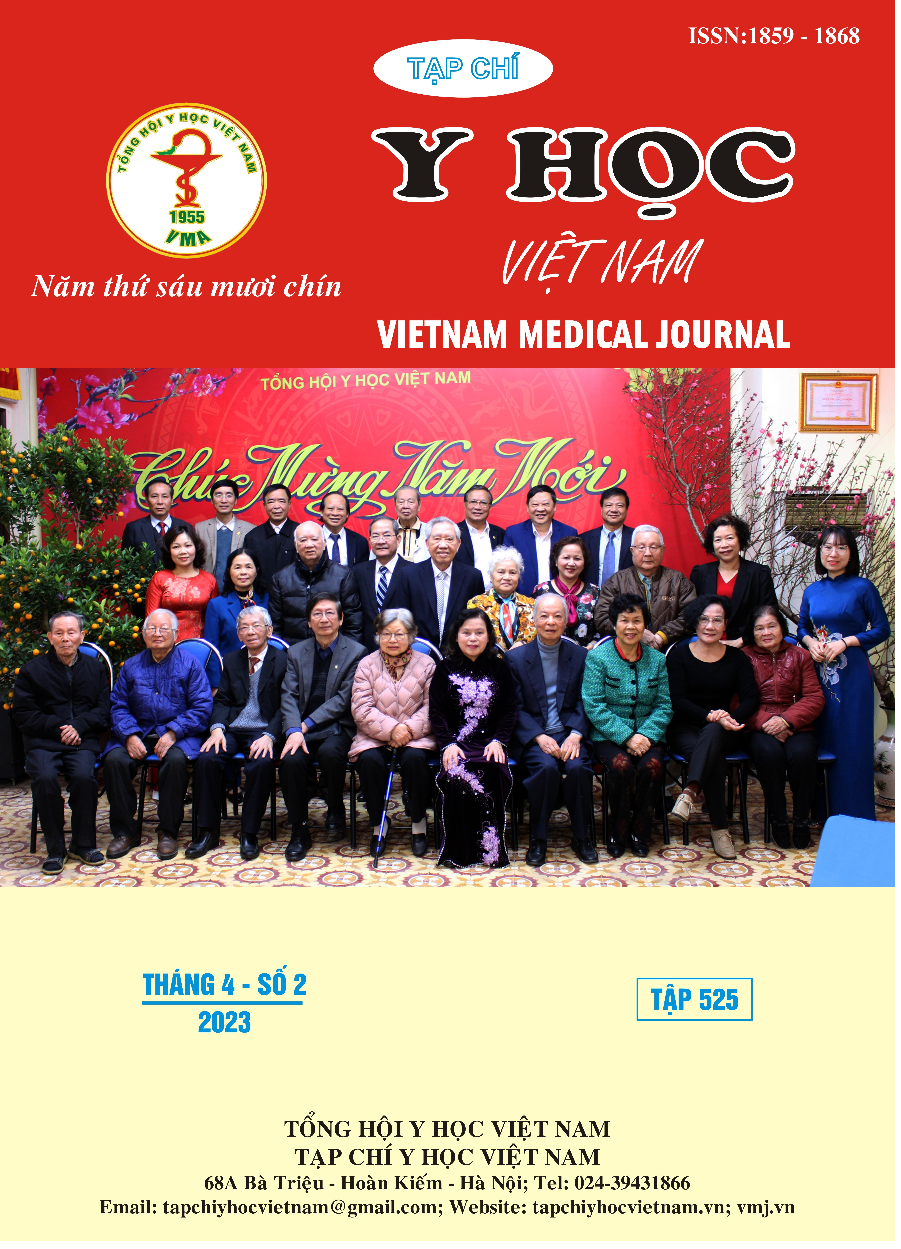ĐÁNH GIÁ KẾT QUẢ SỐNG THÊM VÀ MỘT SỐ YẾU TỐ LIÊN QUAN CỦA PHÁC ĐỒ BEP TRÊN BỆNH NHÂN UNG THƯ TINH HOÀN GIAI ĐOẠN DI CĂN
Nội dung chính của bài viết
Tóm tắt
Mục tiêu nghiên cứu: Đánh giá kết quả sống thêm và một số yếu tố liên quan của phác đồ BEP trên bệnh nhân ung thư tinh hoàn giai đoạn di căn tại bệnh viện K. Đối tượng và phương pháp nghiên cứu: Nghiên cứu mô tả cắt ngang, hồi cứu kết hợp tiến cứu trên 36 bệnh nhân ung thư tinh hoàn giai đoạn di căn được điều trị hóa chất phác đồ BEP tại bệnh viện K từ 1/2014 đến hết tháng 6/2022. Kết quả: Độ tuổi trung bình trong nghiên cứu là 32,6 tuổi. 33,3% bệnh nhân thuộc loại u tế bào dòng tinh và 66,7% bệnh nhân u không phải tế bào dòng tinh. Di căn phổi là vị trí di căn thường gặp nhất chiếm 38,9%. Trung bình thời gian sống thêm bệnh không tiến triển và sống thêm toàn bộ lần lượt là 67,6 tháng và 75,5 tháng. Tỷ lệ sống thêm bệnh không tiến triển và sống thêm toàn bộ tại thời điểm 5 năm là 66,7% và 77,8%. Những bệnh nhân đáp ứng hoàn toàn về mặt sinh hóa và những bệnh nhân phân nhóm nguy cơ trung bình - thấp có thời gian sống thêm bệnh không tiến triển và thời gian sống thêm toàn bộ tốt hơn so với những bệnh nhân không đạt đáp ứng hoàn toàn trên sinh hóa, bệnh nhân phân nhóm nguy cơ cao (p<0,05). Kết luận: Phác đồ BEP đem lại hiệu quả cao, do đó có thể áp dụng áp dụng rộng rãi trong thực hành lâm sàng điều trị ung thư tinh hoàn giai đoạn di căn.
Chi tiết bài viết
Từ khóa
ung thư tinh hoàn, di căn, BEP
Tài liệu tham khảo
2. Cấn Xuân Hạnh: Đánh giá kết quả điều trị ung thư tinh hoàn tại bệnh viện K từ 2005 đến 2013. 2014.
3. Hanna N. và Einhorn L.H. (2014). Testicular cancer: a reflection on 50 years of discovery. J Clin Oncol, 32(28), 3085–3092.
4. De Wit R, Stoter G, Sleijfer DT, et al. Four cycles of BEP versus an alternating regime of PVB and BEP in patients with poor-prognosis metastatic testicular non-seminoma; a randomised study of the EORTC Genitourinary Tract Cancer Cooperative Group. Br J Cancer. 1995;71(6):1311-1314.
5. Culine S, Kramar A, Théodore C, et al. Randomized Trial Comparing Bleomycin /Etoposide/Cisplatin With Alternating Cisplatin/Cyclophosphamide/Doxorubicin and Vinblastine/Bleomycin Regimens of Chemotherapy for Patients With Intermediate- and Poor-Risk Metastatic Nonseminomatous Germ Cell Tumors: Genito-Urinary Group of the French Federation of Cancer Centers Trial T93MP. JCO. 2008;26(3):421-427.
6. Mead GM, Stenning SP. The international germ cell consensus classification: A new prognostic factor-based staging classification for metastatic germ cell tumours. Clinical Oncology. 1997;9(4):207-209.
7. De Wit R, Roberts JT, Wilkinson PM, et al. Equivalence of Three or Four Cycles of Bleomycin, Etoposide, and Cisplatin Chemotherapy and of a 3- or 5-Day Schedule in Good-Prognosis Germ Cell Cancer: A Randomized Study of the European Organization for Research and Treatment of Cancer Genitourinary Tract Cancer Cooperative Group and the Medical Research Council. JCO. 2001;19(6):1629-1640.
8. Grimison PS, Stockler MR, Thomson DB, et al. Comparison of Two Standard Chemotherapy Regimens for Good-Prognosis Germ Cell Tumors: Updated Analysis of a Randomized Trial. JNCI: Journal of the National Cancer Institute. 2010;102(16):1253-1262.
9. Shiraishi T, Nakamura T, Ukimura O. Cancer Registration Committee of the Japanese Urological Association. Chemotherapy for metastatic testicular cancer: The first nationwide multi-institutional study by the Cancer Registration Committee of the Japanese Urological Association. Int J Urol. 2018;25:730-736.
10. Nakamura T, Ueda T, Oishi M, et al. Importance of Continuous Sequential Chemotherapy and Multimodal Treatment for Advanced Testicular Cancer: A High-Volume Japanese Center Experience. Medicine. 2015;94(11):e653.


